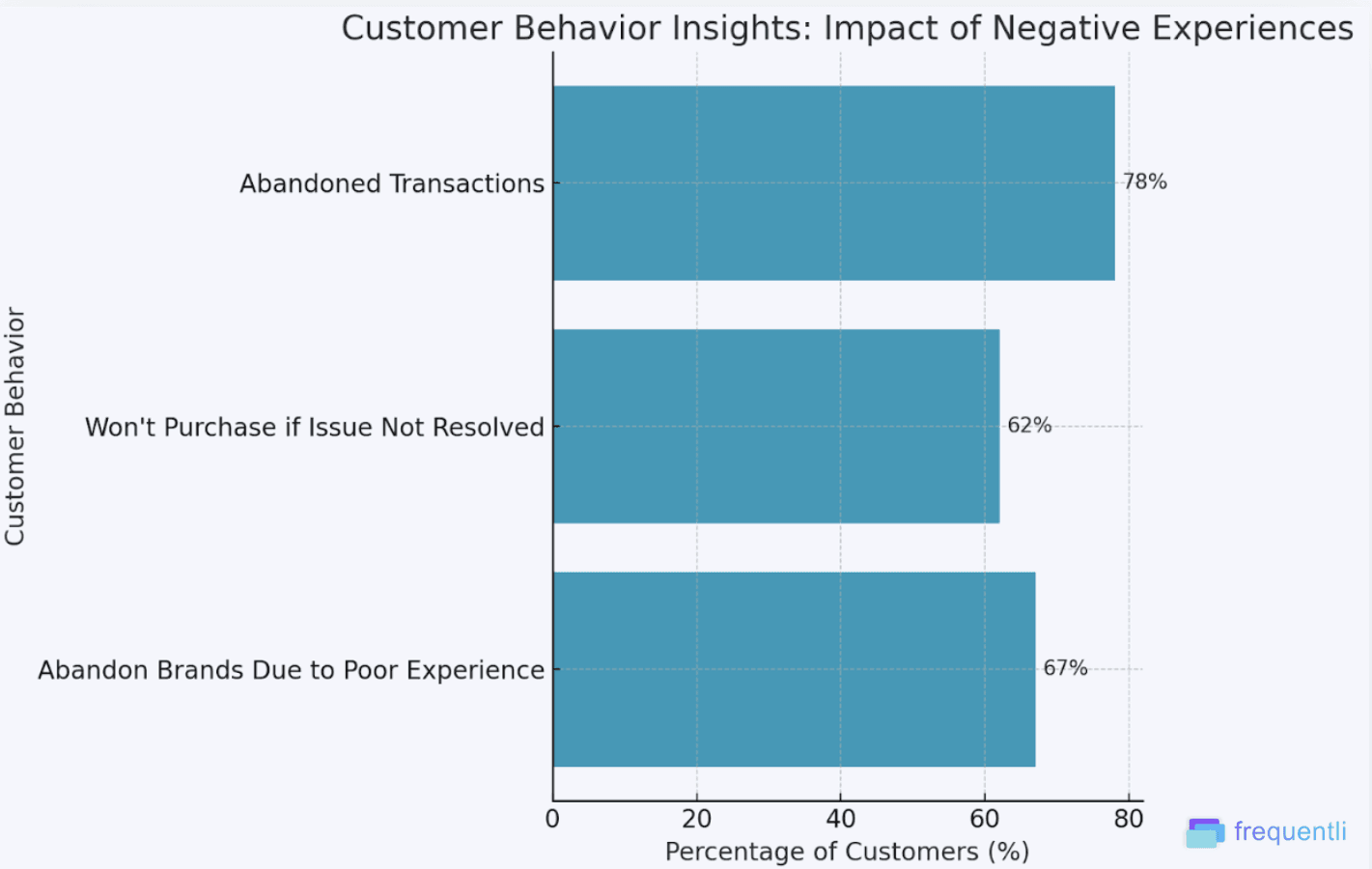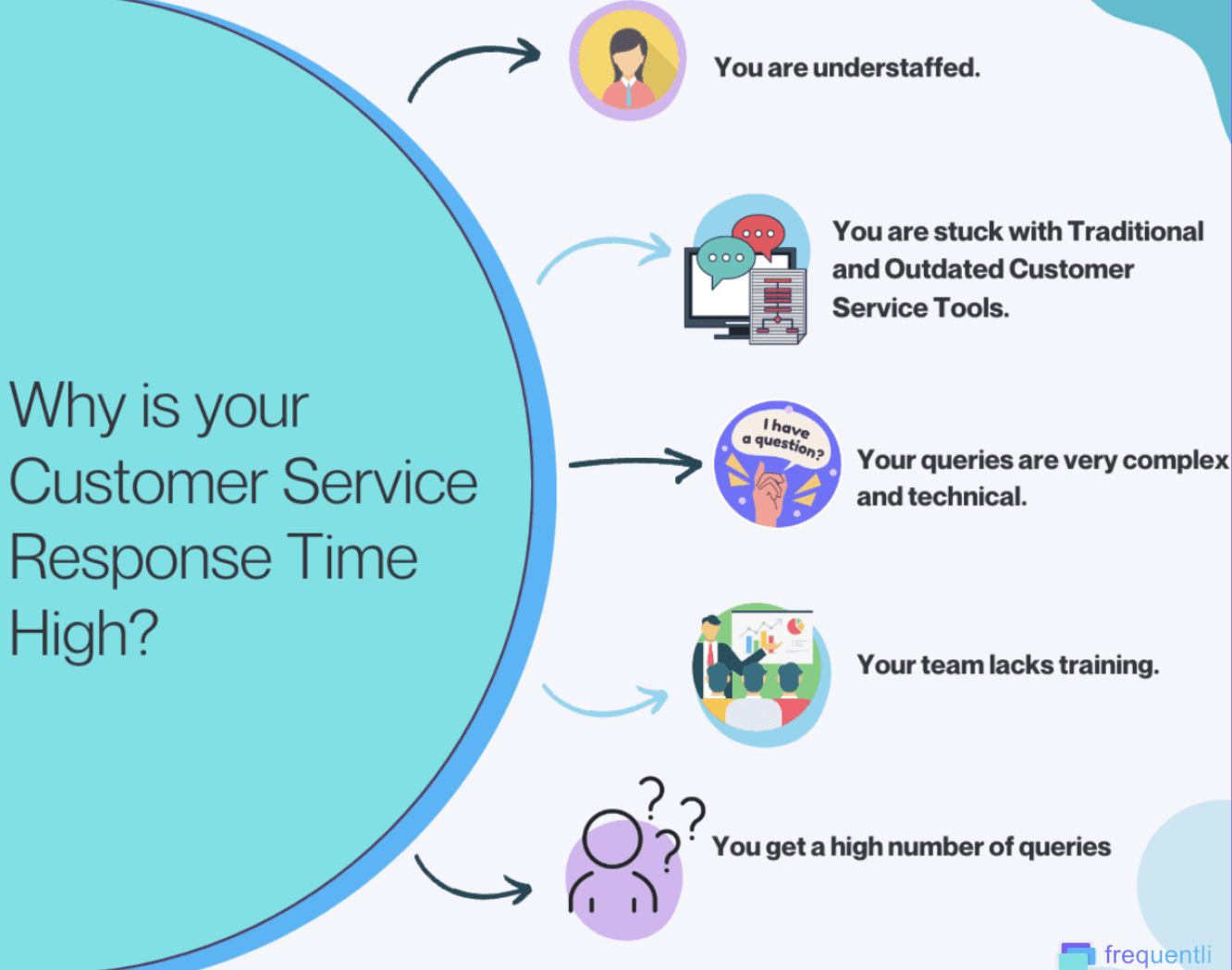Top Factors Contributing to High Customer Service Response Time
Did you know that 82% of consumers expect responses within 10 minutes? Speed is the name of the game in customer support, and when businesses fail to meet these expectations, it can result in lost trust and, ultimately, lost customers.
In fact, research shows that nearly 50% of customers will switch to a competitor after just one bad customer service experience—often due to slow response times.
Quick response times are no longer a luxury—they are a necessity. Every minute counts, whether it’s resolving an issue or answering a simple query. Delays affect customer satisfaction, damage your brand’s reputation, and reduce customer loyalty.
In this article, we’ll explore the top factors contributing to high customer service response times and how addressing these issues can lead to faster, more efficient service. Let’s look at the critical culprits behind slow response times and discuss actionable solutions to resolve them.
Ready? Let’s go!
Impact of High Customer Response Times on Businesses

Impact of High Customer Response Times on Businesses
Poor customer support has led to significant financial losses, with U.S. businesses risking $856 billion annually and global organizations facing up to $3.7 trillion in potential losses due to bad customer experiences.
Figure 1. Customer behavior due to high customer service response times
Meanwhile, over 51% of consumers will reduce or stop spending with a brand after a negative interaction, which rises to over 60% in industries like parcel delivery and fast food.
62% of customers also said that they would not proceed to purchase if their issue wasn't resolved on the first attempt, leading to 78% abandoning transactions due to poor service.
The automotive sector also experiences the highest rate of customer loss post-negative interaction, at 22%, because most queries are primarily complex and take time to answer.
That is why recognizing the significant impact that poor customer support can have on business performance is an essential first step toward improvement. One of the most crucial aspects of customer satisfaction is response time.
Understanding the factors that contribute to high customer service response times allows businesses to take proactive steps to enhance their support processes.
Read more on Step-by-Step Guide: How to Accurately Calculate Average Response Time
Let’s explore some of these key factors together!
Factors Contributing to High Customer Service Response Time

Figure 2. Factors contributing to high customer service response time
Lack of Staffing
One of the most prominent challenges customer service teams face is simply needing more staff to handle the volume of incoming requests.
When a team is understaffed, representatives are stretched too thin, often juggling multiple inquiries simultaneously. This leads to delayed responses, frustrated customers, and a cycle of stress for the support team.
For example, organizations with adequate staffing can respond to inquiries 30% faster than those that are understaffed. This highlights just how important it is to have the right number of people on board to keep things running smoothly.
Teams need more staff to see response times up to 50% longer than they should be. A recent survey revealed that 62% of customers felt dissatisfied due to long wait times—not the experience anyone wants! Plus, companies that don’t tackle these staffing issues may notice a 20% increase in customer churn rates as frustrated customers seek better service elsewhere.
Inefficient Tools and Technology
Even with a well-staffed team, outdated or poorly integrated customer service tools can significantly slow down response times. If customer service representatives are stuck using slow, clunky software or if systems aren’t connected properly, it can take much longer to pull up customer information, track inquiries, and resolve issues. The longer the agents navigate inefficient systems, the longer customers wait.
A survey found that a properly implemented CRM software system can deliver an ROI of over 245%. A recent report by Forrester also found that companies using modern, cloud-based CRM and helpdesk systems reduced their average response time by 40% compared to those still relying on outdated tools like traditional FAQs, for example.
Integrated systems that streamline workflows, automate repetitive tasks, and provide real-time customer insights allow agents to focus more on resolving issues and less on navigating slow platforms.
Complex Customer Queries
Not all customer inquiries are created equal—some are simple and can be resolved quickly, while others are more complex and require specialized knowledge or additional time. These complex issues can significantly slow response times, especially if the team lacks the expertise or resources to handle them efficiently.
For example, resolving a technical issue or addressing a billing dispute may take considerably longer than answering a fundamental question about store hours or product availability.
Approximately 70% of customer service representatives report spending significantly more time on complex inquiries than straightforward requests. This gap is even wider in industries like technology or finance, where customer issues may require in-depth troubleshooting or compliance checks.
Implementing a tiered support structure can be a highly effective way to handle complex queries without affecting overall response times. Here's how it works:
First-tier support: Frontline customer service agents handle basic queries and common issues. These are quick fixes that can be resolved with minimal effort.
Escalation to second-tier or expert support: More complicated issues that require specialized knowledge or additional research are escalated to experts in the relevant areas.
This ensures that customers get the best possible solution without unnecessary delays in the initial response.
3. Ineffective Training and Knowledge Gaps
One often overlooked factor in slow customer service response times is ineffective training or gaps in agent knowledge. When customer service representatives are not adequately trained, they take longer to troubleshoot and resolve customer issues.
Without the right knowledge, agents may need to escalate cases unnecessarily or spend time seeking answers that should be readily available. This not only increases the time it takes to resolve individual issues but can also create bottlenecks during busy periods.
Organizations that invest in comprehensive training programs experience an increase in customer satisfaction scores by 20% or more. Additionally, 70% of customers feel more satisfied when their inquiries are handled by knowledgeable representatives.
These statistics underscore the importance of equipping agents with the right tools and information to address customer needs effectively and quickly.
High Volume of Inquiries
This is also called the Seasonal Surge effect. A sudden surge in customer inquiries, especially during sales, product launches, or peak seasons like holidays, can overwhelm even well-prepared customer service teams.
As the number of inquiries spikes, response times lengthen because there simply aren’t enough resources to efficiently manage the flood of requests. This increased load can create backlogs, leading to frustrated customers and declining service quality.
For example, during major sales events such as Black Friday or Cyber Monday, companies can experience an increase in inquiries by as much as 300% compared to regular periods.
According to Zendesk research, customer service inquiries increase by as much as 42% during peak seasons, and companies that fail to manage this surge see response times rise by 30-50%. The same study found that businesses that plan for these periods by implementing scalable solutions significantly reduce the impact on response times.
Poor Prioritization and Ticket Management
The last factors that cause high customer service response time are poor prioritization and ticket management. Teams often handle inquiries, from simple questions to complex, time-sensitive issues. Without proper prioritization, urgent requests can easily get lost in the queue, buried beneath less important or routine matters.
This mismanagement leads to longer response times and frustrates customers who expect a quicker resolution for their critical concerns.
A case study by Zendesk highlighted that companies with well-defined ticket prioritization processes saw an improvement in their first response times from 24 hours to just 6 hours for high-priority requests.
Additionally, organizations implementing effective ticket prioritization strategies have been shown to reduce their average response time by up to 40%. That is why effective ticket management is essential to ensure that the most critical issues are addressed first.
Comprehensive Solutions to Reduce Customer Service Response Times
To address all the factors contributing to high customer service response times, here are three comprehensive solutions businesses can implement:
1. Invest in Automation and AI Tools
Implementing AI-powered chatbots, dynamic customer service systems, and automated ticket routing systems can help manage surges in customer inquiries.
These automation tools can handle routine tasks such as answering frequently asked questions or assigning tickets based on their priority. A dynamic FAQ section, for example, can resolve simple inquiries, deflecting them from live agents, while automated ticket systems can prioritize and route more complex or urgent cases.
According to a report by Gartner, businesses that utilize AI-driven tools have reduced response times by up to 60% during peak periods, and companies using automated ticket routing report a 30% faster resolution for high-priority issues
2. Enhance Training and Provide Knowledge Resources
Training customer service teams in soft skills and product knowledge is also a potential solution as it equips them to handle queries more efficiently. Access to a well-structured knowledge base allows agents to reference solutions and resolve issues quickly. Continuous training ensures that agents are always prepared to handle complex inquiries, improving both response time and customer satisfaction.
A McKinsey report indicates that comprehensive training programs can reduce average handling time by 20%.
3. Implement Scalable Staffing Models and Flexible Workflows
Businesses often experience a surge in inquiries during peak seasons, product launches, or sales. Implementing flexible staffing models—such as temporary or outsourced support—can help companies scale their customer service teams to handle this demand.
Additionally, optimizing workflows with real-time collaboration tools can help predict when additional staffing is needed, ensuring enough agents are always available during busy periods.
Zendesk reports that companies that adopt scalable staffing models and optimize workflow management report 42% fewer delayed responses during peak seasons, maintaining strong customer satisfaction even during high-demand periods.
In Summary
Throughout this article, we've explored several key factors that contribute to high customer service response times:
Lack of Staffing: Understaffed teams struggle to manage incoming inquiries efficiently, leading to delayed responses.
Inefficient Tools and Technology: Outdated or poorly integrated systems slow down agents and make it easier to resolve issues quickly.
Complex Customer Queries: Difficult problems take longer to solve, but proper escalation and a tiered support structure can minimize delays.
Ineffective Training and Knowledge Gaps: With thorough training, agents can find solutions, impacting both speed and quality of service.
High Volume of Inquiries: During peak seasons, requests can overwhelm teams, resulting in backlogs.
Poor Prioritization and Ticket Management: When tickets aren't properly prioritized, urgent issues get buried under minor ones, leading to longer response times.
Addressing these factors by implementing automation tools, enhancing training, adopting scalable staffing models, and improving ticket management can significantly reduce response times and improve customer satisfaction.
Take a moment to assess your customer service practices. Are you facing delays due to any of the factors we've discussed?
Adopting the strategies outlined here can drastically improve response times. Make sure to also tune in to our next blog, where we’ll discuss Expert Tips to Automate Tedious Customer Service Tasks.
